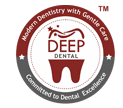Teeth discolor due to stains on the surface or by internal changes. Discoloration can be due to:
External discoloration:- The outer layer of the tooth the (enamel) is stained due to coffee, wine, cola or
other drinks, foods or smoking.
Internal discoloration:- The inner structure of the tooth darkens or gets a yellow tint if:
- You had too much fluoride during early childhood.
- Your mother used tetracycline antibiotics during pregnancy.
- You used tetracycline antibiotics when you were 8 years old or younger.
- You had trauma that affected a tooth when you were a young child.
- You were born with a rare condition called dentinogenesis imperfect. This causes gray, amber or purple dis colorations.
Age-related discoloration:- Over time teeth naturally yellows as the enamel gets thinner with age.
Diagnosis:-
No special tests are needed. A dentist can diagnose tooth discoloration looking at the teeth.
Solution:-
After Tooth discoloration can be removed with professional cleaning. In some cases, if the discoloration is severe, VENEERING may be required to cover it.

What is Veneering?
Dental veneers (sometimes called porcelain veneers or dental porcelain laminates) are wafer-thin, custom- made shells of tooth-colored materials designed to cover the front surface of teeth to improve appearance. These shells are bonded to the front of the teeth changing their color, shape, size, or length.
Dental veneers can be made from porcelain or from resin composite materials. Porcelain veneers resist stains better than resin veneers and better mimic the light reflecting properties of natural teeth. Resin veneers are thinner and require removal of less of the tooth surface before placement. You will need to discuss the best choice of veneer material for you with your DENTIST.

Procedure of getting a veneer:-
Getting a dental veneer usually requires three trips to the dentist one for a consultation and two to make and apply the veneers. One tooth or many teeth can simultaneously undergo the veneering process described below.
Diagnosis and treatment planning:- During the first visit your dentist will examine your teeth to make sure dental veneers are appropriate for you. X-rays and impressions of your mouth and teeth may be taken.
Preparation:- To prepare a tooth for a veneer, your dentist will remove about 0.5 to 1.0 millimeter of enamel from the tooth surface after giving a local anesthetic to numb the area. Next, your dentist will make a model or impression of your tooth.
Bonding:- Your tooth will be cleaned, polished, and etched which roughens the tooth to allow for a strong bonding process. A special cement is applied to the veneer and the veneer is then placed on your
tooth. Once properly position on the tooth your dentist will apply a light beam to the dental veneer, which causes it to harden quickly. The final steps involve evaluating your bite and making any final adjustments in the veneer. Your dentist may ask you to return for a follow-up visit in a couple of weeks to check how your gums are responding to the presence of your veneer and to examine the veneers placement.
Types of Veneer Procedures:-
Your cosmetic dentist will recommend the most appropriate tooth veneers procedure for you.
Composite Veneer Procedure:- Composite (direct) veneers usually need a single visit to your cosmetic dentist. The procedure is an application of a bond and enamel directly to the tooth’s surface.
Porcelain Veneer Procedure:- Porcelain (indirect) veneers usually require two visits to the dentist and require a dental laboratory to create the final tooth restoration piece.
Pros and Cons of Veneer:-
Advantages Porcelain veneers create new smiles and smile makeovers in a very short period of time. typically veneers are difficult to stain, making veneers a very popular solution for many people. Strong and very durable, veneers last from ten to fifteen years and are in colors that will brighten dark teeth without the worry of them changing color. Veneers don’t require extensive shaping procedures and can actually strengthen your tooth. There is no additional maintenance, other than a follow-up visit to your cosmetic dentist and proper brushing and flossing on a daily basis.
Disadvantages Veneers are permanent. They may temporarily cause your teeth to become more sensitive because of the removal of enamel. Some people can experience a difference in speech, usually pronouncing “s and “f” sounds. This is corrected through minor adjustments to your veneers. There may be slight variations in the color of veneers compared to natural teeth.
Lumineers:-
Lumineers are a popular veneer option because they are a “minimal preparation” or “no-preparation” procedure. Made of Crenate porcelain, they are contact lens-thin, roughly 0.2 mm thick. This technique is best used with patients who have spacing in their smile and only minor tooth rotations. Lumineers do not require the dentist to grind, cut or file down any tooth structure for proper placement. The veneers are adhesively bonded to the facial (front) surface” of the teeth, making the process as much of a minimally invasive procedure as possible.
Lumineers vs. Traditional Veneers:-
Traditional veneers require the grinding down of your original tooth structure. This can be a painful, anxious experience that many patients prefer to avoid. Lumineers are unique in that they are ultra-thin (approximately 0.2 mm and highly translucent, allowing them to replicate the natural appearance of enamel. Lumineers are so thin they require little to no tooth reduction and no shots. Once the procedure is completed, there is no tooth sensitivity or placement discomfort, so they look and feel natural from the moment they are placed.
With Lumineers you can eat and drink anything you want with confidence because they are applied in the most durable way possible. With Lumineers you get:-
- A painless procedure
- Sensitivity-free results
- Permanently white results that last
- A quick and easy process.
Smiling should be a happy, enjoyable experience, not stressful or embarrassing now with VENEERS share your smile with the world.

